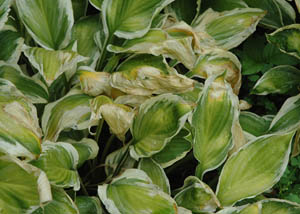Hosta Scorch and Possible Look-Alikes | |
|---|---|
| June 26, 2007 | |
|
Hostas grow best in shade or partial shade. They thrive where there is a good amount of soil organic matter to help retain moisture. If hostas are grown in full sun, especially in soil with low organic matter, they develop yellow foliage with scorched margins, as in the image.  Under drought conditions, leaves become pale or dull and leaf margins scorched. This is not an infectious disease. You will not find any fruiting bodies or spores of a pathogen on these leaves. Watering the soil early in the day helps temporarily, but planting in a semi-shaded or shaded site in high-organic-matter soil is the best long-range management. Under drought conditions, leaves become pale or dull and leaf margins scorched. This is not an infectious disease. You will not find any fruiting bodies or spores of a pathogen on these leaves. Watering the soil early in the day helps temporarily, but planting in a semi-shaded or shaded site in high-organic-matter soil is the best long-range management.If you have scorch symptoms on your hostas and are concerned that you may be missing something bigger, here are some diseases to consider: anthracnose (common), Sclerotium blight (occasional), foliar nematodes (rarely), Fusarium crown and root rot (rarely), and viruses (occasional). The only disease that might be confused with environmental scorch is anthracnose. This disease is caused by aspecies of the Colletotrichum fungus. It thrives in warm, wet weather; so it may appear on irrigated hostas. I would not expect to see it in drought conditions where plants have not been irrigated. Symptoms include large irregular spots with darker borders. The centers of spots often fall out, and leaves become tattered and torn. Fruiting bodies are small (pinhead-sized) masses of clear spores with small, black, hairlike structures (setae) sticking out of the spore mass. Obviously, the symptoms are a bit different than scorch symptoms. Scorch is not caused by a pathogen and does not have spores or fruiting bodies. Fusarium root and crown rot is a problem we have seen a few times, especially in production areas. This disease causes leaf yellowing, stunting, rotting of roots, and death of crown tissues. It can be distinguished from scorch by inspecting the roots. Plants with environmental scorch have white roots or roots with white growing tips. Sclerotium blight has become a serious disease of hostas because it is persistent and causes collapse of the foliage. Initially, lower leaves wilt and brown. In a short time, the upper leaves also wilt; and close inspection shows a soft, brown rot of the base of petioles. The fungus, Sclerotium rolfsii, appears as a fluffy, white mass of mycelium on the petioles and surrounding soil. Tiny tan, mustardseed-sized sclerotia (fungal structures) can be seen in this mycelium and on the soil. Symptoms do not appear similar to scorch. Foliar nematodes on hosta are also relatively new to our area. At this time, we are not seeing a big problem in Illinois, but the possibility is real. Nematodes are microscopic roundworms that cause disease. They are pathogens much like a fungus or bacterium, but they require moisture to infect; and they live within the plant. The foliar nematodes are in the genus Aphelenchoides. On hosta, the nematode feeds in the leaf, producing brown areas between veins. The brown areas in the foliage may take on various shapes, usually limited by veins. Scorch may also occur between veins; but unlike foliar nematodes, it also involves leaf edges and leaf tips. Viruses that infect hostas cause mottling of the foliage, crinkling, stunting, and some necrosis. The symptoms do not resemble leaf scorch. Keep these diseases in mind when trying to confirm a case of environmental scorch. �� | |
| Author: | Nancy Pataky |
